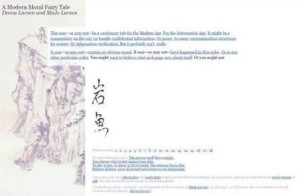What do you know about electronic literature? Since the 1980s, electronic literature has engaged authors, readers, software developers, and critics.
Combining literature and technology, the pieces are designed to be experienced on a computer. One subgenre, hypertext fiction, is known for its use of hyperlinks to new passages, creating a unique and nonlinear experience for every reader.
The Maryland Institute for Technology in the Humanities (MITH) is a digital humanities center that “engages in collaborative, interdisciplinary work at the intersection of technology and humanistic inquiry.” One of MITH’s current projects is “The Deena Larsen Collection (DLC),” a collection of the personal computers and software of Deena Larsen, a pioneer of the hypertext genre.
Deena Larsen is a hypertext author who’s been active since the 1980s. She’s best-known for Marble Springs, which debuted in 1993 as one of the first hypertext poetry collections. Marble Springs revolves around the lives of women in a Colorado mining town between the mid-1800s and mid-1900s and is written as a collection of poems in the style of Spoon River Anthology. Larsen is a prolific author and amateur archivist responsible for collecting old computers, outdated software, and a wide body of electronic literature that would otherwise be difficult if not impossible to locate.
The collection is notable for containing not only Larsen’s work, but the work of nearly every writer from her creative circle, producing an impressive cross-section of the  early electronic literature community. Among the materials are the unpublished or first-edition works of Larsen and multiple other authors.
early electronic literature community. Among the materials are the unpublished or first-edition works of Larsen and multiple other authors.
To explain the importance of the DLC, MITH Associate Director Matthew Kirschenbaum says: “The Deena Larsen Collection at MITH–what Deena herself terms the “Great Library of Alexandria”–is a major resource for the study not only of electronic literature, but early personal computing and the Web, offering researchers a cross-section of software, hardware, and documentation from a period that already seems like ancient history.”
While open to interested scholars, the Deena Larsen Collection is difficult to access from a distance. There is interest in digitizing the collection, but MITH faces obstacles related to intellectual property rights (as the collection contains works from authors other than Larsen), and the challenge of transferring and storing delicate electronic materials.
The official collection website has photographs of some of the artifacts but digitization of the collection is slow-going. Currently, the best way to work with the collection is in-person via a scheduled visit to MITH.
The Deena Larsen Collection at MITH represents not just the work of one author, but an entire community. It represents the early potential of the Internet, and how electronic literature developed via community, experimentation, and curiosity.
- Larsen’s personal website, including links to an online version of Marble Springs and most of her other works, is available here.
- If you’re interested in developing your own electronic literature, check out Larsen’s free textbook, Fun da mentals.
- To schedule a visit to access the Larsen Collection, contact MITH.

